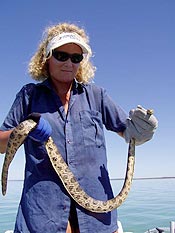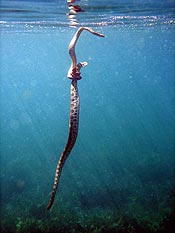
Research Projects – Sea Snakes


Seasnakes don't like to hunt over sand when the tide is high and they might run into sharks!
Sea Snakes

in nearshore habitats of shark bay
There are at least six sea snakes that are found in Shark Bay, but the most common in our study area are the bar-bellied sea snake (Hydrophis elegans) and the olive-headed sea snake (Disteria major). Sea snakes are common prey for tiger sharks in Shark Bay despite being among the most venomous snakes on earth. Tiger sharks are not affected by this venom when they eat the snake.
Although sea snakes are highly venomous, they are generally quite docile and we often encounter them when we are snorkeling or diving during seagrass studies. In fact, sea snakes are found throughout Shark Bay, but are often seen hunting in the seagrass (click here to see a video of a sea snake eating) where there are many fishes that they could eat. The bar-bellied sea snake is a foraging specialist. They eat only one type of fish – snake eels.
Sea Snake Studies

and below)


Because sea snakes are common prey of tiger sharks, we were interested in determining the seasonal patterns of their abundance and whether their habitat and microhabitat use changed in response to tiger sharks.
To determine the seasonal abundance and habitat use patterns of sea snakes, we drive along transects found in deep and shallow habitats and record the location and species of every sea snake that we see at the surface within 5m of the boat. Within shallow habitats we have transects over seagrass and sand that we can drive along during perfect sighting conditions when we can reliably observe snakes underwater to determine whether they are foraging. For a sea snake, being over sand is dangerous. If a tiger shark is in the area, it will likely see the snake and there is nowhere for the snake to hide. In fact, the snake may never even see the shark - they often have to poke their head deep into the burrows of their snake eel prey and can't be on the lookout for a predator. On the other hand, sea snakes weaving their way through the seagrass are almost impossible to see and a tiger shark would have a hard time catching them.
The abundance of sea snakes changes with season. They are more abundant in the summer than the winter. In some winters, snakes are almost completely absent from our study area while in other years they are present all year.
Bar-bellied sea snakes are the most common species followed by olive-headed sea snakes Both species are found more commonly in shallow habitats than in deep habitats, but they appear to partition the habitat. Bar-bellied sea snakes are generally found in nearshore shallows while olive-headed sea snakes are found primarily over offshore banks and the surrounding deep-water channels.
Both species of snakes change how they use their shallow habitats in response to tiger sharks. Bar-bellied sea snakes in nearshore shallows are rarely found over sand bottoms (where their snake eel prey is most abundant) when the tide is high and tiger sharks can access these shallow sand flats. When the tide is low, many snakes move into the sandy areas where they are probably looking for food. Olive-headed sea snakes are distributed across offshore seagrass banks relatively evenly when tiger sharks are in low abundance but shift to spending their time mainly in the middle of banks, and avoiding edges of banks, where they are less likely to encounter a shark.
Sea Snake Studies Publications
- Wirsing, A. J. and M. R. Heithaus. 2009. Olive-headed sea snakes (Disteria major) shift seagrass microhabitats to avoid shark predation. Marine Ecology Progress Series 387: 287-293.
- Kerford, M. A., A. J. Wirsing, M. R. Heithaus, and L. M. Dill. 2008. Danger on the rise: habtiat use by bar-bellied sea snakes in Shark Bay, Western Australia. Marine Ecology Progress Series 358: 289-294.
- Heithaus, M. R., L. M. Dill, G. J. Marshall, and B. Buhleier. 2002. Habitat use and foraging behavior of tiger sharks (Galeocerdo cuvier) in a seagrass ecosystem. Marine Biology 140: 237-248. (includes data on habitat use by sea snakes)
- Heithaus, M. R. 2001. The biology of tiger sharks (Galeocerdo cuvier) in Shark Bay, Western Australia: sex ratio, size distribution, diet, and seasonal changes in catch rates. Environmental Biology of Fishes 61: 25-36. (includes data on seasonal variation in snake numbers).
All photographs copyrighted; Images may be used for educational purposes. For use in other forms contact Mike Heithaus

